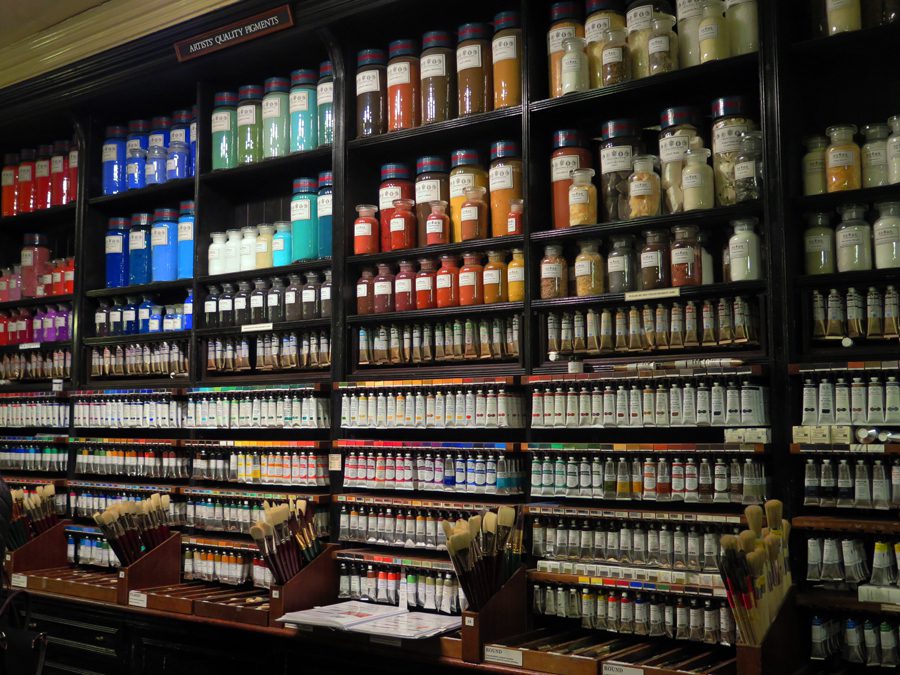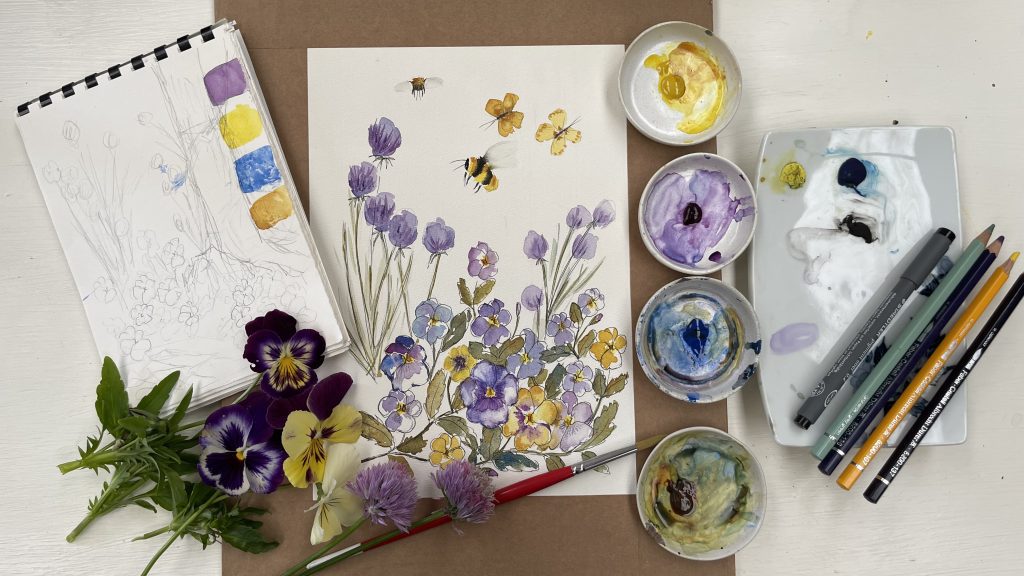Paints
Whether you have an entire room or a corner of the kitchen table as your art space, there are certain things you need to equip yourself with in order to be able to paint in watercolor. In this article I plan to talk about what I have in my studio as a core of materials and equipment, and also the extras for equipping your studio which make a big difference to your work – some of which are very small and inexpensive. I have some useful suggestions for you on how to equip your art studio.


There is a huge range nowadays of painting supplies, and the modern beginner is privileged to have a choice which by far outdoes the selection of makes and types that were available to us only a couple of decades ago. There are several brands which are budget friendly and yet good quality when equipping your studio, but you must be wary of fancy packaging which might disguise inferior contents. If you want to be sure of starting on the right footing, then choose a basic package of paints, brushes and other paraphernalia from a well-known and long-standing manufacturer, who you can rely on for permanence and reliability. Then add the icing on the cake later on once you have an idea of what you really want to paint.


Although paint is not necessarily the first thing we should talk about when deciding on equipping your studio, it is undoubtedly the most interesting – and the most confusing – topic of all. For most of my painting life I have used Winsor and Newton Artists range, their Cotman student range, and also Rowney Artists range. The reason for this is simple: when I started painting, living in the UK, those were the only watercolor paints in the shops. This was before the advent into the country of “foreign” manufacturers such as Schmincke (Germany) and Sennelier (France) which were only available in the fancy specialist shops in London. Japanese paints were unheard of. At that time I usually bought my paints from W.H. Smith & Sons – a store which was founded over 200 years ago and for many years was the best source of art materials in many provincial towns. London had Cornelisson’s, an art supply store founded by a Belgian, where many exotic materials could be sourced, but it wasn’t until 1960, when Cowling & Wilcox opened their first store, and followed with provincial art stores, that a variety of different manufacturers slowly became available to the general public.
My Basic Palette
For this reason, my basic palette for many, many years consisted of the following colors, from Winsor and Newton. They still form the basis of a landscape palette which will serve all artists well when equipping your studio. Unless you intend to only ever paint florals, you will need the following colors, from which you will be able to mix an infinite number of shades and tints.
- Blues
- cobalt blue
- ultramarine blue
- winsor or pthalo blue
- cerulean blue
- Yellows
- lemon yellow
- cadmium yellow
- yellow ochre
- Reds
- cadmium red
- alizarin crimson
- permanent rose
- winsor violet
- Greens
- sap green
- olive green
- Browns
- raw sienna
- burnt sienna
- burnt umber
- sepia
- Neutrals
- lamp Black
- Chinese White
- Paynes Grey
These 20 colours are available in all reputable brand ranges. The color of each individual pigment will vary slightly from brand to brand, as will the level of opacity and translucence. It is up to you to choose a brand which suits both your budget and color taste, but I recommend that you select for you starter palette one of the following manufacturers, upon whom you can definitely rely for quality and value for money. Within this selection you will find some more expensive, some less, so depending on your budget you can still have good quality paints as the backbone of your painting life.


My Floral Palette
For painting flowers and other subjects from nature you will do the best work if you choose transparent, clean colors. Luckily for us 21st century artists, we have an abundance of synthetic colors to chose from. Here are my suggestions for a floral palette.
- Quinacridone Rose
- Hansa Yellow Medium
- Quinacridone Gold
- Burnt Sienna
- Ultramarine
- Phthalo Green
- Pyrrol Crimson
- Transparent Pyrrol Orange
Daniel Smith is a reliable source for all these colors and is recommended.
And a word about paint form – should you choose pans or tubes? I use tubes in the studio mostly, and have sets of pans for traveling. You can mix washes better with soft, tube paint. And if you want, you can squeeze some out and let it dry on your palette, and use it as if it were a pan. So with tubes you have the best of both worlds.
And here is a link to a page which gives information about the history of most of the paint manufacturers. It makes fascinating reading. For example, did you know that Grumbacher started out as importers of Schmincke paints from Germany, bought the licence to produce their paints in the US and later eliminated reference to Schmincke yet continued to produce their paints in the same way? Who knew?
Here are my recommended manufacturers roughly in the order in which I investigated them myself. I have named first the Artists quality for each brand, and then the Students version if there is one. Both will serve you well, and a combination of both or any is fine. I suggest you also try out different brands to see which you prefer.
- Winsor & Newton (Artists)
- Winsor & Newton Cotman (Students)
- Daler Rowney (Artists)
- Daler Rowney Georgian (Students)
- Schmincke Horadam (Artists)
- Schmincke Akademie (Students)
- Sennelier Aquarelle (Artists)
- Sennelier La Petite Aquarelle (Students)
- Royal Talens Rembrandt (Artists)
- Royal Talens Van Gogh (Students)
- M Graham & Co. (Artists)
- Grumbacher Finest (Artists)
- Grumbacher Academy (Students)
- Da Vinci (Artists)
- Maimeri Blu (Artists)
- Old Holland Classic (Artists)
- Holbein (Artists)
- Lukas Aquarell Studio (Artists)
- Lefranc & Bourgeois (Artists)
- Daniel Smith (Artists)
- Yarka (Artists)
- Yarka St Petersburg White Nights (Students)
- Qor (Artists)
Student versus Artists Grade when Equipping your studio
Essentially Student grade paints contain less pigment, more filler, and possibly cheaper versions of pigments, than artists quality paints. They may also be less finely milled, have inferior handling properties, be less lightfast and permanent. In other words, if you can manage it, it’s better to buy Artists quality paints when equipping your studio. However, any of the Student quality paints in this list are superior and far more desirable and useful than the cheap “no-name” watercolor sets you will find on the shelves of craft stores everywhere now, not to mention on Amazon etc. Those are to be avoided if you are want to learn the real watercolor techniques. Why? Because you won’t be able to achieve the “real watercolor techniques” with inferior paints, period.
My recommendations when equipping your studio? If you are in England, Winsor and Newton Artists (now called Professional for some reason). If you are in mainland Europe, I’d go for Old Holland for price versus quality, Schmincke if I was feeling rash. In the States, a beginner might go for Grumbacher or Da Vinci.